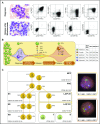Hematopoietic stem cell involvement in BCR-ABL1- positive ALL as a potential mechanism of resistance to blinatumomab therapy
- PMID: 28827408
- PMCID: PMC5726343
- DOI: 10.1182/blood-2017-05-782888
Hematopoietic stem cell involvement in BCR-ABL1- positive ALL as a potential mechanism of resistance to blinatumomab therapy
Abstract
The bispecific T-cell engager blinatumomab targeting CD19 can induce complete remission in relapsed or refractory B-cell precursor acute lymphoblastic leukemia (BCP-ALL). However, some patients ultimately relapse with loss of CD19 antigen on leukemic cells, which has been established as a novel mechanism to escape CD19-specific immunotherapies. Here, we provide evidence that CD19-negative (CD19-) relapse after CD19-directed therapy in BCP-ALL may be a result of the selection of preexisting CD19- malignant progenitor cells. We present 2 BCR-ABL1 fusion-positive BCP-ALL patients with CD19- myeloid lineage relapse after blinatumomab therapy and show BCR-ABL1 positivity in their hematopoietic stem cell (HSC)/progenitor/myeloid compartments at initial diagnosis by fluorescence in situ hybridization after cell sorting. By using the same approach with 25 additional diagnostic samples from patients with BCR-ABL1-positive BCP-ALL, we identified HSC involvement in 40% of the patients. Patients (6 of 8) with major BCR-ABL1 transcript encoding P210BCR-ABL1 mainly showed HSC involvement, whereas in most of the patients (9 of 12) with minor BCR-ABL1 transcript encoding P190BCR-ABL1, only the CD19+ leukemia compartments were BCR-ABL1 positive (P = .02). Our data are of clinical importance, because they indicate that both CD19+ cells and CD19- precursors should be targeted to avoid CD19- relapses in patients with BCR-ABL1-positive ALL.
© 2017 by The American Society of Hematology.
Conflict of interest statement
Conflict-of-interest disclosure: D.K. was on an advisory board for Incysus, Ltd and Qu Biologics, Inc. H.P. received honoraria from Amgen, Novartis, and Jazz Pharmaceuticals and was on an advisory board for Incyte. M. Brüggemann participated in contract research for Amgen, Roche, Affimed, and Regeneron; received honoraria from Amgen, Roche, and Pfizer; and was on an advisory board for Amgen and Incyte. M.S.T. performed research under contract for Amgen, Affimed, and Regeneron and served on an advisory board for Amgen and Regeneron. N.G. performed research under contract for Amgen and Pfizer and received honoraria from Amgen and Pfizer. The remaining authors declare no competing financial interests.
Figures


Comment in
-
Anti-CD19 resistance can "stem" from progenitors.Blood. 2017 Nov 2;130(18):1961-1963. doi: 10.1182/blood-2017-09-804070. Blood. 2017. PMID: 29097371 Free PMC article.
References
-
- Topp MS, Gökbuget N, Zugmaier G, et al. . Phase II trial of the anti-CD19 bispecific T cell-engager blinatumomab shows hematologic and molecular remissions in patients with relapsed or refractory B-precursor acute lymphoblastic leukemia. J Clin Oncol. 2014;32(36):4134-4140. - PubMed
-
- Klinger M, Brandl C, Zugmaier G, et al. . Immunopharmacologic response of patients with B-lineage acute lymphoblastic leukemia to continuous infusion of T cell-engaging CD19/CD3-bispecific BiTE antibody blinatumomab. Blood. 2012;119(26):6226-6233. - PubMed
-
- Topp MS, Gökbuget N, Stein AS, et al. . Safety and activity of blinatumomab for adult patients with relapsed or refractory B-precursor acute lymphoblastic leukaemia: a multicentre, single-arm, phase 2 study. Lancet Oncol. 2015;16(1):57-66. - PubMed
Publication types
MeSH terms
Substances
LinkOut - more resources
Full Text Sources
Other Literature Sources
Medical
Miscellaneous

